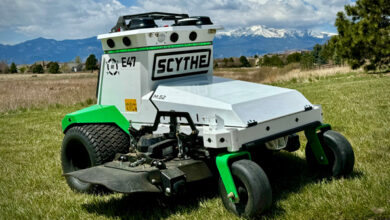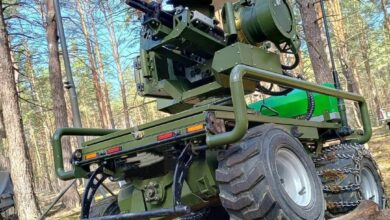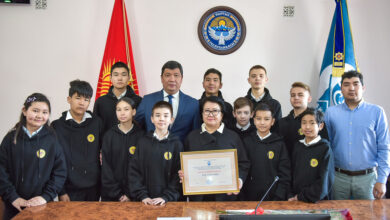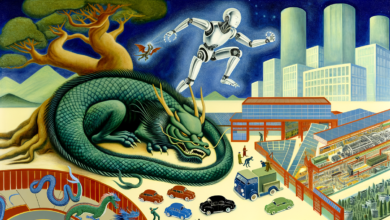NVIDIA, Teradyne Robotics, and Siemens discuss autonomous machines and AI
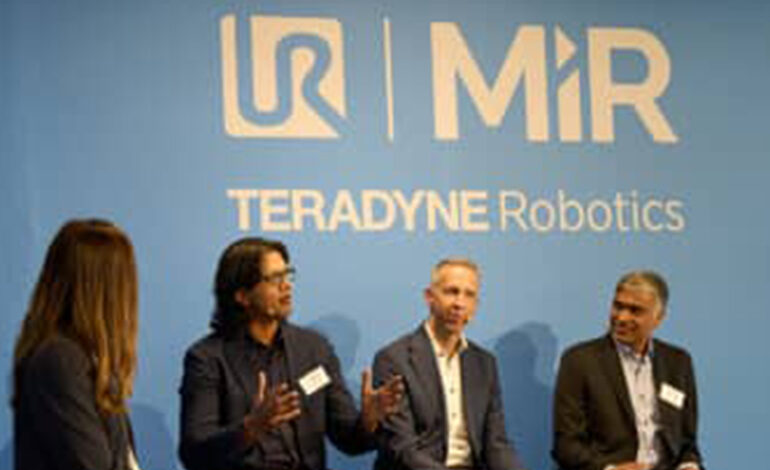
|
Listen to this article |
Senior executives from NVIDIA, Siemens, and Teradyne Robotics gathered this week in Odense, Denmark, to mark the launch of Teradyne Robotics’ new headquarters and discuss the advances coming to the robotics industry.
One of Denmark’s oldest cities and known as “the city of robotics,” Odense is home to more than 160 robotics companies with 3,700 employees and said it contributes to the robotics industry’s progress.
Teradyne Robotics’ new hub there includes collaborative robotics leader Universal Robots (UR) and autonomous mobile robot (AMR) company Mobile Industrial Robots (MiR). The company said it will help maximize employee collaboration, foster innovation, and provide an environment to revolutionize advanced robotics and autonomous machines.
The grand opening showcased the latest AI robotic applications and featured a panel discussion on the future of advanced robotics. Speakers included Ujjwal Kumar, group president of Teradyne Robotics; Rainer Brehm, CEO of Siemens Factory Automation; and Deepu Talla, vice president of robotics and edge computing at NVIDIA.
“The advent of generative AI, coupled with simulation and digital twins technology, is at a tipping point right now, and that combination is going to change the trajectory of robotics,” commented Talla.
Panelists tout the power of partnerships
The event occurred as the global robotics market continues to grow rapidly. The cobot market in Europe was valued at $286 million in 2022 and is projected to reach $6.7 billion by 2032 at an annual growth rate of more than 37%, according to Statzon.
The panelists discussed why teaming up is key to innovation for any company — whether a startup or an enterprise. They also talked about how physical AI is being used across businesses and workplaces, stressing the game-changing impact of advanced robotics.
The alliance between NVIDIA and Teradyne Robotics, which includes an AI-based intralogistics system alongside Siemens, showcases the strength of collaboration across the ecosystem. NVIDIA said its prominent role as a physical AI hardware provider is boosting the cobot and AMR sectors with accelerated computing, while its collaboration with Siemens is transforming industrial automation.
“NVIDIA provides all the core AI capabilities that get integrated into the hundreds and thousands of companies building robotic platforms and robots, so our approach is 100% collaboration,” Talla said.
“What excites me most about AI and robots is that collaboration is at the core of solving our customers’ problems,” Kumar added. “No one company has all the technologies needed to address these problems, so we must work together to understand and solve them at a very fast pace.”
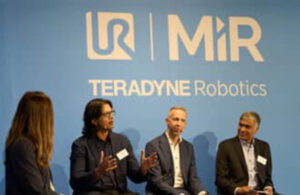
From left to right: Fleur Nielsen, head of communications at Universal Robots; Deepu Talla, head of robotics at NVIDIA; Rainer Brehm, CEO of Siemens Factory Automation; and Ujjwal Kumar, president of Teradyne Robotics. | Source: NVIDIA, Steffen Stamp
AI to accelerate innovation
AI has already made huge strides across industries and plays an important role in enhancing advanced robotics, said NVIDIA, Teradyne, and Siemens. Leveraging machine learning, computer vision and natural language processing, AI gives robots the cognitive capability to understand, learn and make decisions.
“For humans, we have our senses, but it’s not that easy for a robot, so you have to build these AI capabilities for autonomous navigation,” Talla said. “NVIDIA’s Isaac platform is enabling increased autonomy in robotics with rapid advancements in simulation, generative AI, foundation models, and optimized edge computing.”
NVIDIA is working closely with Universal Robots to infuse AI into UR’s robotics software. In the case of AMRs that move things from Point A to B to C, it’s all about operating in unstructured environments and navigating autonomously, said Talla.
Brehm emphasized the need to scale AI by industrializing it, allowing for automated deployment, inference, and monitoring of models — making AI easily accessible on the shopfloor. He spoke about empowering customers to utilize AI effortlessly, even without AI expertise.
“Our goal is to advance automation, moving towards a system that leverages skills-based automation in the future,” Brehm said.
As a leading robotics company with one of the largest installed bases of cobots and AMRs, Teradyne has identified a long list of industry problems and is working with NVIDIA to solve them.
“I use the term ‘physical AI’ as opposed to ‘digital AI’ because we are taking AI to a whole new level by applying it in the physical world,” said Kumar, who delivered a keynote at the Robotics Summit & Expo earlier this month. “We see it helping our customers in three ways: adding new capabilities to our robots, making our robots smarter with advanced path planning and navigation, and further enhancing the safety and reliability of our collaborative robots.”
Robotics has a real-world impact, say Teradyne, NVIDIA, and Siemens
Autonomous machines, or AI robots, are already making a noticeable difference in the real world, from industries to people’s daily lives. Industries such as manufacturing are using advanced robotics to enhance efficiency, accuracy, and productivity.
Companies want to produce goods close to where they are consumed, with sustainability being a key driver, noted the speakers. But this often means setting up shop in high-cost countries. The challenge is twofold: producing at competitive prices and dealing with shrinking, aging workforces that are less available for factory jobs.
“The problem for large manufacturers is the same as what small and medium manufacturers have always faced: variability,” Kumar said. “High-volume industrial robots don’t suit applications requiring continuous design tweaks. Collaborative robots combined with AI offer solutions to the pain points that small and medium customers have lived with for years, and to the new challenges now faced by large manufacturers.”
Automation isn’t just about making things faster; it’s also about making the most of the workforce, explained Teradyne Robotics, NVIDIA, and Siemens. In manufacturing, automation can aid smoother processes, ramps up safety, saves time and relieves pressure on employees.
“Automation is crucial for solving problems and, to get there, AI is a game-changer,” Brehm said. “If you don’t have the people who want to work in the factory, and you don’t have the people to program the automation, you won’t have the flexibility to automate what you need in the future. And that’s what drives our customers.”
AI and computing technologies are set to redefine the robotics landscape, transforming robots from mere tools to intelligent partners capable of autonomy and adaptability across industries, said the panelists.
 Submit your presentation idea now.
Submit your presentation idea now.
 About the author
About the author
Gerard Andrews is a senior product marketing manager focused on the robotics developer community. Prior to joining NVIDIA, he was at Cadence, where he was product marketing director, responsible for product planning, marketing, and business development for licensable processor IP. Andrews holds an M.S. in electrical engineering from Georgia Institute of Technology and a B.S. in electrical engineering from Southern Methodist University.
